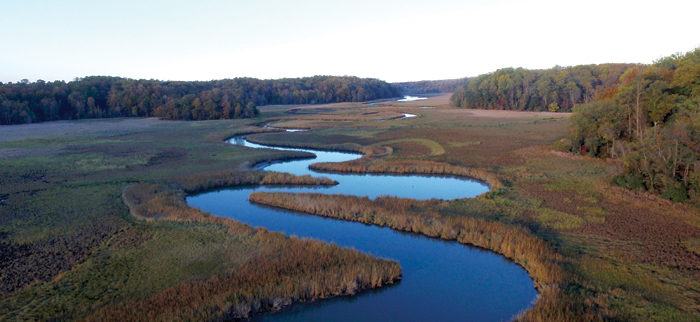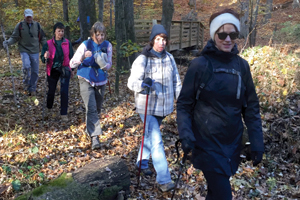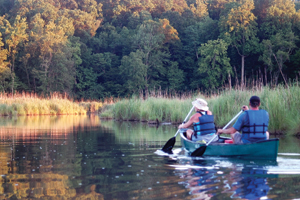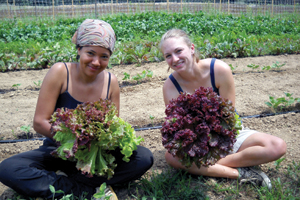The Parkers Creek Preserve: A land preservation success story

The creek from the air; by Tony Pucciarella
On the western shore of the Chesapeake Bay, there is a place where you can paddle through 2 miles of tidal marsh and see no signs of human development; where you can explore 20 miles of hiking trails through 3,000 acres of permanently protected woodlands and see native wildlife and plants flourish. This place is known as the Parkers Creek Preserve, and it is a testament to powerful partnerships and successful land conservation.
The American Chestnut Land Trust—a small non-profit dedicated to protecting land within Calvert County watersheds—manage the entire preserve including the nearly 1,000 acres it has purchased for conservation.

Hikers on the Prince Frederick to the Bay Trail; courtesy of the land trust
Early days
In December 1986, a group of conservation-minded citizens pledged their own time and funds to protect the initial 436-acre wooded tracts where our South Side trail system is now located. Over the next seven years, dedicated members and volunteers conserved more than 200 additional acres on the south side of Parkers Creek before purchasing our first property on the northern side in 1994. It was then that the Maryland Department of Natural Resources and the Nature Conservancy formed a partnership with us that spurred the protection of all of the land immediately surrounding this beautiful and ecologically valuable waterway.
A lasting partnership
As this publication celebrates its 20th anniversary, we celebrate our partnership with the department, which has lasted nearly as long. In 1995, the department began purchasing properties on each side of the creek—making up what is now the Parkers Creek Wildlife Management Area—with the understanding that our staff and volunteers would manage the day-to-day operations of the preserve.
Today, the land is a mosaic of properties protected not only by us, but also through Calvert County land preservation programs and by private property owners.
The unique ecology of its nearly pristine wetlands and forests supports an array of rare, threatened and endangered species, as well as some of our favorite wildlife such as beavers, bald eagles and otters. Parkers Creek has been called the Chesapeake Bay in miniature as it ranges from brackish tidal water to forested headwater streams. Vegetation along the sinuous main stem also changes in response to the varying salinity concentrations.

Paddlers out on the creek; courtesy of the land trust
A pristine example
Since our formation, the American Chestnut Land Trust has embraced the values of sustainability and environmental awareness. Thanks to that and the dedication of the Department of Natural Resources, the Parkers Creek watershed is more than 70 percent forested and contains less than 4 percent impervious surfaces, despite encompassing half of the town of Prince Frederick. Water quality monitoring by both county scientists and volunteers indicates that it is one of the healthiest streams on the western shore of the Chesapeake Bay.
The surrounding land is largely protected, but that doesn’t mean that we aren’t striving for an even healthier system. Our recently formed science committee examines ways to determine the overall biodiversity within the preserve, establishing where more could be done to further improve the health of the system and assess which efforts work over time. We also hope to work with businesses and landowners near the headwaters of the watershed to mitigate the effects of stormwater runoff before it reaches our streams. By using science to constantly improve the ways we care for the land, the Parkers Creek Preserve serves as a model for watershed-level conservation and stewardship.

Volunteers harvesting lettuce; courtesy of the land trust
Public engagement
Another result from this great partnership is access to enhanced outdoor recreation. The Prince Frederick to the Bay Trail is the ultimate collaboration of efforts, as it allows hikers to travel from the center of Prince Frederick across church, state, county and trust-owned properties all the way to the Chesapeake Bay. The preserve’s newest trail—the North-South—connects communities on both sides of Parkers Creek. These trail systems, which have always been separated by water, are now linked via two new miles of pathway and a raft that allows hikers a unique way to cross the creek.
With a motto of connecting people with the land, we provide a multitude of ways for the community to experience the preserve. In addition to 22 miles of hiking trails and guided canoe trips, we also offer a sustainable agricultural program including a one-acre volunteer-run farm, educational garden and food forest. The majority of the naturally grown produce is donated to a local food pantry. Guided visits are offered to school and youth groups for both the farm and the preserve as a whole.
The Parkers Creek Preserve is also a favorite of outdoorsmen and women who help manage the deer herd. This is critical for maintaining a diverse and healthy ecosystem. Public hunters who meet the state requirements may hunt deer on department-owned lands during archery, shotgun and muzzleloader seasons.
| Maryland Master Naturalists are interested, ecologically aware people who have successfully completed a fun but rigorous natural history training program. Each year, they devote 40 volunteer hours participating in citizen science efforts, teaching classes, leading field trips and sharing their enthusiasm for our natural areas and the life forms that occupy them. |
A variety of other educational, athletic and volunteer events help people get involved in meaningful ways. Whether it’s competing in a triathlon, improving wildlife habitat or completing the Maryland Master Naturalist training program, there is something for everyone to experience and enjoy here.
Article by Autumn Phillips-Lewis—conservation biologist and American Chestnut Land manager.
Appears in Vol. 20, No. 2 of the Maryland Natural Resource magazine, spring 2017.


 1-888-373-7888
1-888-373-7888 233733
233733